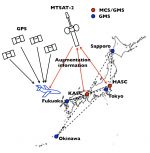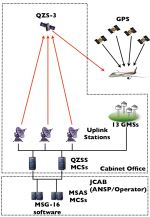If you wish to contribute or participate in the discussions about articles you are invited to contact the Editor
MSAS Ground Segment: Difference between revisions
No edit summary |
Gema.Cueto (talk | contribs) (Updated with V2 plans) |
||
| Line 7: | Line 7: | ||
|Title={{PAGENAME}} | |Title={{PAGENAME}} | ||
}} | }} | ||
The MTSAT Satellite Augmentation System ([[MSAS General Introduction|MSAS]]) is the Japanese [[SBAS General Introduction|Satellite Based Augmentation System (SBAS)]] System:<ref name="MSAS_STATUS_2007">[http://www.unoosa.org MSAS Current Status, Japan Civil Aviation Bureau,] [http://www.oosa.unvienna.org/oosa/SAP/gnss/icg/icg02/presentations.html Second Meeting of the International Committee on Global Navigation Satellite Systems (ICG) organized by the International Space Research Organization, Bangalore, India , 5 - 7 September 2007]</ref> a GPS Augmentation system with the goal of improving its accuracy, integrity, and availability | The MTSAT Satellite Augmentation System ([[MSAS General Introduction|MSAS]]) is the Japanese [[SBAS General Introduction|Satellite Based Augmentation System (SBAS)]] System:<ref name="MSAS_STATUS_2007">[http://www.unoosa.org/ MSAS Current Status, Japan Civil Aviation Bureau,] [http://www.oosa.unvienna.org/oosa/SAP/gnss/icg/icg02/presentations.html Second Meeting of the International Committee on Global Navigation Satellite Systems (ICG) organized by the International Space Research Organization, Bangalore, India , 5 - 7 September 2007]</ref> a GPS Augmentation system with the goal of improving its accuracy, integrity, and availability. | ||
First tests were accomplished successfully, and MSAS system for aviation use was declared operational in September 27, 2007,<ref name="MSAS_STATUS_2007_2">QZSS / MSAS Status, CGSIC –47th Meeting ,Fort Worth, Texas September25, 2007, Satoshi KOGURE, [http://www.jaxa.jp/index_e.html Japan Aerospace Exploration Agency,] QZSS Project Team</ref><ref name="MSAS_GPSW">[http://www.gpsworld.com/surveyperspectives-late-april-2008-7289 Eric Gakstatter, Perspectives - Late April 2008, GPSworld, April 15, 2008]</ref><ref name=MSAS_WIKI_2>[http://en.wikipedia.org/wiki/Multi-functional_Satellite_Augmentation_System Multi-functional Satellite Augmentation System] in [http://en.wikipedia.org/ Wikipedia]</ref> providing a service of horizontal guidance for En-route through Non-Precision Approach.<ref name="MSAS_STATUS_2007"/><ref name="MSAS_STATUS_2007_2"/><ref name="MSAS_STATUS_2008">[http://www.unoosa.org/ Overview of MSAS, Presentation for ICG-3, 2008]</ref> | |||
First tests were accomplished successfully, and MSAS system for aviation use was declared operational in September 27, 2007,<ref name="MSAS_STATUS_2007_2">QZSS / MSAS Status, CGSIC –47th Meeting ,Fort Worth, Texas September25, 2007, Satoshi KOGURE, [http://www.jaxa.jp/index_e.html Japan Aerospace Exploration Agency,] QZSS Project Team</ref><ref name="MSAS_GPSW">[http://www.gpsworld.com/surveyperspectives-late-april-2008-7289 Eric Gakstatter, Perspectives - Late April 2008, GPSworld, April 15, 2008]</ref><ref name=MSAS_WIKI_2>[http://en.wikipedia.org/wiki/Multi-functional_Satellite_Augmentation_System Multi-functional Satellite Augmentation System] in [http://en.wikipedia.org/ Wikipedia]</ref> providing a service of horizontal guidance for En-route through Non-Precision Approach.<ref name="MSAS_STATUS_2007"/><ref name="MSAS_STATUS_2007_2"/><ref name="MSAS_STATUS_2008">[http://www.unoosa.org Overview of MSAS, Presentation for ICG-3, 2008]</ref> | The SBAS signal used to be transmitted from MTSAT (Multi-functional Transport Satellites) operated by the Ministry of Land, Infrastructure, Transport and Tourism (MLIT). The SBAS signal that is made by MLIT is now transmitted from the QZS-3 GEO satellite using the QZSS SBAS transmission service since April 2020.<ref name="QZSS_SBAS">[https://qzss.go.jp/en/overview/services/sv12_sbas.html SBAS Transmission Service], QZSS Official Website</ref> | ||
==MSAS Ground Segment== | ==MSAS Ground Segment== | ||
[[File:MSAS2019.jpg|MSAS architecture in 2019. <ref name="GBAS_SBAS">[https://www.icao.int/APAC/APAC-RSO/GBASSBAS%20Implementation%20Workshop/3-2_GBAS_SBAS%20Implementation%20Perspective-Rev%202%20(S%20Saito).pdf GBAS/SBAS Implementation | |||
Perspective - Japan] Susumu Saito, GBAS/SBAS International Workshop, Seoul, 3-5 June 2019</ref>|thumb|upright=0.5]] | |||
[[File:MSASV2Plans.jpg|MSAS V2 planned configuration <ref name="GBAS_SBAS"/>.|thumb|upright=0.5]] | |||
MSAS works by processing GPS data collected by a network of reference stations to generate the SBAS message which is uploaded to the GEO satellites. The GEO satellites broadcast this information to the user receivers, which compute the aircraft positioning and inform on potential alert messages.<ref name="MSAS_STATUS_2008"/> | MSAS works by processing GPS data collected by a network of reference stations to generate the SBAS message which is uploaded to the GEO satellites. The GEO satellites broadcast this information to the user receivers, which compute the aircraft positioning and inform on potential alert messages.<ref name="MSAS_STATUS_2008"/> | ||
The MSAS system components are typically divided in three different segments: the ground segment, encompassing the system assets located on ground, the [[MSAS Space Segment|space segment]], including the GEO satellites used to broadcast the information to the users, and the [[MSAS User Segment|user segment]], consisting in the users themselves. | The MSAS system components are typically divided in three different segments: the ground segment, encompassing the system assets located on ground, the [[MSAS Space Segment|space segment]], including the GEO satellites used to broadcast the information to the users, and the [[MSAS User Segment|user segment]], consisting in the users themselves. | ||
The MSAS Ground Segment is composed of | The MSAS Ground Segment is composed of two main elements: | ||
* Ground Monitor Stations (GMS) that collect information on the GPS and MSAS signals. | |||
* Master Control Stations (MCS) that, using that information, compute precise differential corrections and integrity bounds and send them to the MSAS satellites for rebroadcast to the User Segment. | |||
The original MSAS Ground Segment configuration included 6 GMS in Sapporo, Tokyo, Fukuoka, Naha, Kobe and Hitachi-Ota; 2 MCS in Kobe and Hitachi-Ota; and 2 MRS (Monitoring and Ranging Stations) in Camberra and Hawaii that were decommissioned in 2015. | |||
For the DFMC SBAS test being carried out since 2018, L5 SBAS ground facilities had to be set up <ref name="Trial">[https://www.enri.go.jp/~sakai/pub/isgnss2016_sakai.pdf Japanese SBAS Program: Current Status and Dual-Frequency Trial]Takeyasu Sakai, National Institute of Maritime, Port and Aviation Technology</ref>. | |||
For the MSAS V2 (2020 – 2023) a full replacement of the SBAS ground system is planned increasing the number of GMS stations to 13 and adding 3 Uplink Stations in domestic soil in order to provide LPV operation and LVP-200 at some major airports <ref name="Trial"/>. | |||
==References== | ==References== | ||
<references/> | <references/> | ||
[[Category:MSAS]] | [[Category:MSAS]] | ||
Latest revision as of 13:50, 29 September 2021
| MSAS | |
|---|---|
| Title | MSAS Ground Segment |
| Edited by | GMV |
| Level | Basic |
| Year of Publication | 2011 |
The MTSAT Satellite Augmentation System (MSAS) is the Japanese Satellite Based Augmentation System (SBAS) System:[1] a GPS Augmentation system with the goal of improving its accuracy, integrity, and availability. First tests were accomplished successfully, and MSAS system for aviation use was declared operational in September 27, 2007,[2][3][4] providing a service of horizontal guidance for En-route through Non-Precision Approach.[1][2][5] The SBAS signal used to be transmitted from MTSAT (Multi-functional Transport Satellites) operated by the Ministry of Land, Infrastructure, Transport and Tourism (MLIT). The SBAS signal that is made by MLIT is now transmitted from the QZS-3 GEO satellite using the QZSS SBAS transmission service since April 2020.[6]
MSAS Ground Segment


MSAS works by processing GPS data collected by a network of reference stations to generate the SBAS message which is uploaded to the GEO satellites. The GEO satellites broadcast this information to the user receivers, which compute the aircraft positioning and inform on potential alert messages.[5]
The MSAS system components are typically divided in three different segments: the ground segment, encompassing the system assets located on ground, the space segment, including the GEO satellites used to broadcast the information to the users, and the user segment, consisting in the users themselves.
The MSAS Ground Segment is composed of two main elements:
- Ground Monitor Stations (GMS) that collect information on the GPS and MSAS signals.
- Master Control Stations (MCS) that, using that information, compute precise differential corrections and integrity bounds and send them to the MSAS satellites for rebroadcast to the User Segment.
The original MSAS Ground Segment configuration included 6 GMS in Sapporo, Tokyo, Fukuoka, Naha, Kobe and Hitachi-Ota; 2 MCS in Kobe and Hitachi-Ota; and 2 MRS (Monitoring and Ranging Stations) in Camberra and Hawaii that were decommissioned in 2015. For the DFMC SBAS test being carried out since 2018, L5 SBAS ground facilities had to be set up [8]. For the MSAS V2 (2020 – 2023) a full replacement of the SBAS ground system is planned increasing the number of GMS stations to 13 and adding 3 Uplink Stations in domestic soil in order to provide LPV operation and LVP-200 at some major airports [8].
References
- ^ a b MSAS Current Status, Japan Civil Aviation Bureau, Second Meeting of the International Committee on Global Navigation Satellite Systems (ICG) organized by the International Space Research Organization, Bangalore, India , 5 - 7 September 2007
- ^ a b QZSS / MSAS Status, CGSIC –47th Meeting ,Fort Worth, Texas September25, 2007, Satoshi KOGURE, Japan Aerospace Exploration Agency, QZSS Project Team
- ^ Eric Gakstatter, Perspectives - Late April 2008, GPSworld, April 15, 2008
- ^ Multi-functional Satellite Augmentation System in Wikipedia
- ^ a b Overview of MSAS, Presentation for ICG-3, 2008
- ^ SBAS Transmission Service, QZSS Official Website
- ^ a b [https://www.icao.int/APAC/APAC-RSO/GBASSBAS%20Implementation%20Workshop/3-2_GBAS_SBAS%20Implementation%20Perspective-Rev%202%20(S%20Saito).pdf GBAS/SBAS Implementation Perspective - Japan] Susumu Saito, GBAS/SBAS International Workshop, Seoul, 3-5 June 2019
- ^ a b Japanese SBAS Program: Current Status and Dual-Frequency TrialTakeyasu Sakai, National Institute of Maritime, Port and Aviation Technology
